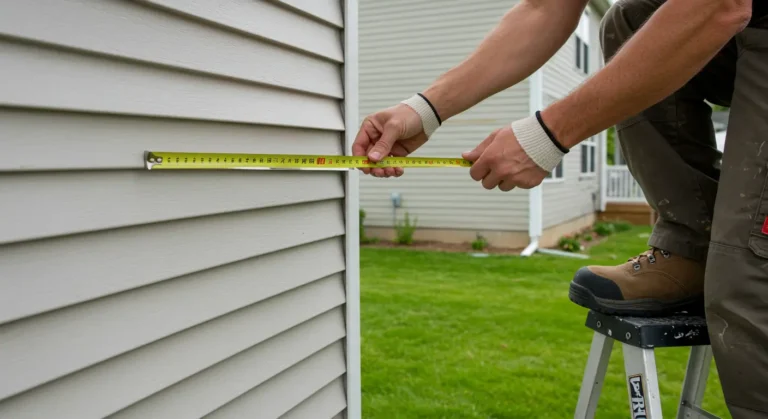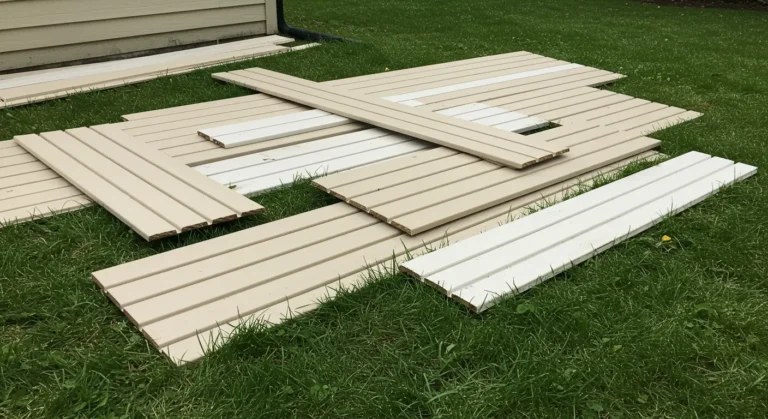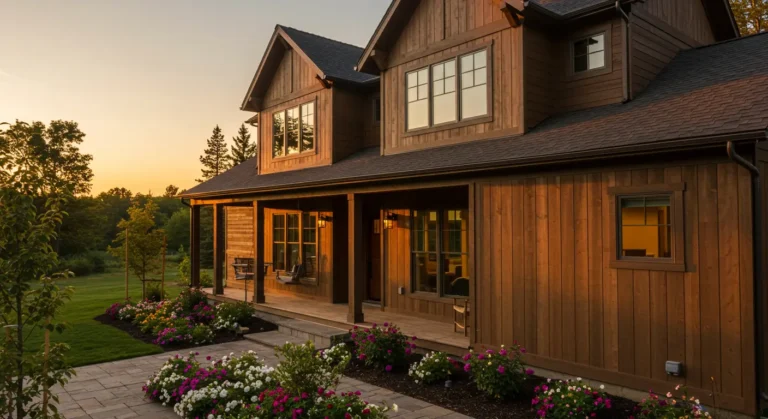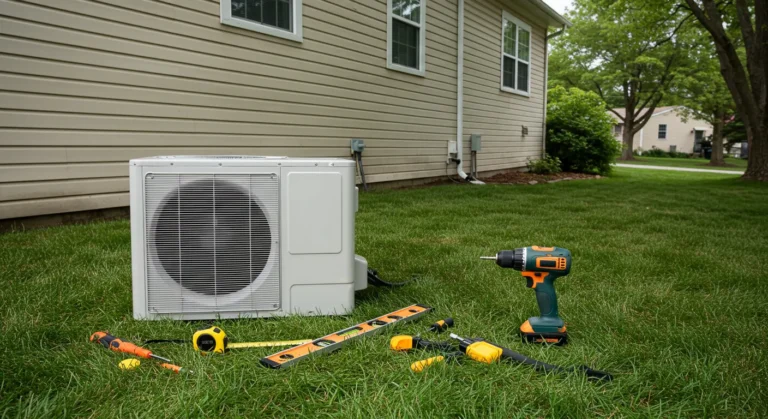Vinyl siding is a durable, cost-effective choice for homeowners but like any exterior material, it’s not invincible. In places like Louisiana, where heavy rain, high humidity, and frequent storms are common, siding damage is inevitable over time. Cracked, warped, or loose vinyl siding doesn’t just ruin curb appeal, it can lead to water intrusion, mold, and costly repairs if left unchecked.
The good news? Many minor vinyl siding issues can be fixed without calling in a contractor. This guide breaks down how to fix vinyl siding step-by-step, including DIY patching, panel replacement, maintenance tips, tool recommendations, and when to contact a professional.
Common Types of Vinyl Siding Damage

Understanding the type and cause of damage is the first step in choosing the right repair approach.
1. Cracked Vinyl Siding
Cracks often occur due to hail, flying debris during storms, or direct impact (like a baseball). Small cracks can be patched, but larger or multiple cracks may require replacing the panel.
2. Warped Panels
Warping is frequently caused by heat especially from BBQ grills placed too close or from improper installation where the siding isn’t allowed to “float.”
3. Loose or Rattling Panels
Loose siding often results from high winds, aging fasteners, or inadequate nailing. It can allow moisture behind the panels, damaging the wall structure.
4. Holes or Punctures
Holes from storm debris or tools need immediate attention. Even small punctures can let in water, bugs, and mold.
5. Discoloration and Mildew
While not always structural, discoloration and mildew are signs of poor drainage or trapped moisture common in Louisiana’s humid climate.
Pro tip: Don’t ignore even small issues. Moisture from storms can sneak behind your siding and cause serious structural problems over time. Schedule a free siding inspection if you notice persistent discoloration or bubbling.
Tools & Materials You’ll Need for Vinyl Siding Repair
Having the right tools makes DIY siding repair much easier and safer.
Basic Tools:
- Vinyl siding zip tool – Essential for unlocking and relocking panels
- Utility knife – For cutting replacement panels or patches
- Hammer or cordless drill – For removing/replacing nails or screws
- Measuring tape – Accurate sizing is critical for clean repairs
- Level – To ensure replacement panels sit evenly
Materials:
- Replacement vinyl siding panel(s) – Always match the color and style
- Siding patch kit – Ideal for small cracks or holes
- Exterior-grade caulk – Seals gaps and prevents water entry
- Galvanized nails or screws – Rust-resistant fasteners
- Safety gear – Gloves, eye protection, ladder with stabilizer
Optional but helpful:
- Caulk gun
- Siding removal tool
- Work apron or tool belt
You can find a complete DIY guide in this step-by-step vinyl siding repair guide.
How to Fix Cracked or Broken Siding
DIY Vinyl Siding Patch Method
This approach is perfect for cracks less than 6 inches or surface-level breaks:
- Clean the area thoroughly using soap, water, and a brush.
- Cut a vinyl patch from a matching panel. Use a utility knife for precise sizing.
- Apply exterior-grade caulk around the cracked area.
- Press the patch into place, ensuring it overlaps all edges of the crack.
- Seal the edges with more caulk and smooth with your finger.
Let it cure for 24–48 hours depending on humidity.
For homeowners in Louisiana, make sure to use mildew-resistant caulk to prevent moisture issues in humid months.
How to Replace a Vinyl Siding Panel
Sometimes patching isn’t enough, especially for warped or shattered panels.
Full Panel Replacement Steps:
- Use a zip tool to unlock the siding panel above the damaged one.
- Slide the zip tool along the seam, gently pulling the panel downward.
- Remove nails or screws from the damaged panel.
- Lift out the panel carefully without damaging the surrounding siding.
- Cut a new panel to size if necessary.
- Slide the new panel into place, aligning the lock seam.
- Nail the new panel, leaving slight room for expansion.
- Re-lock the top panel with the zip tool.
Matching color can be difficult if your siding has faded. Bring a sample to your local siding supplier or contact Lone Wolf Siding’s repair experts for professional help.
Repair vs. Replace: When to Call a Professional
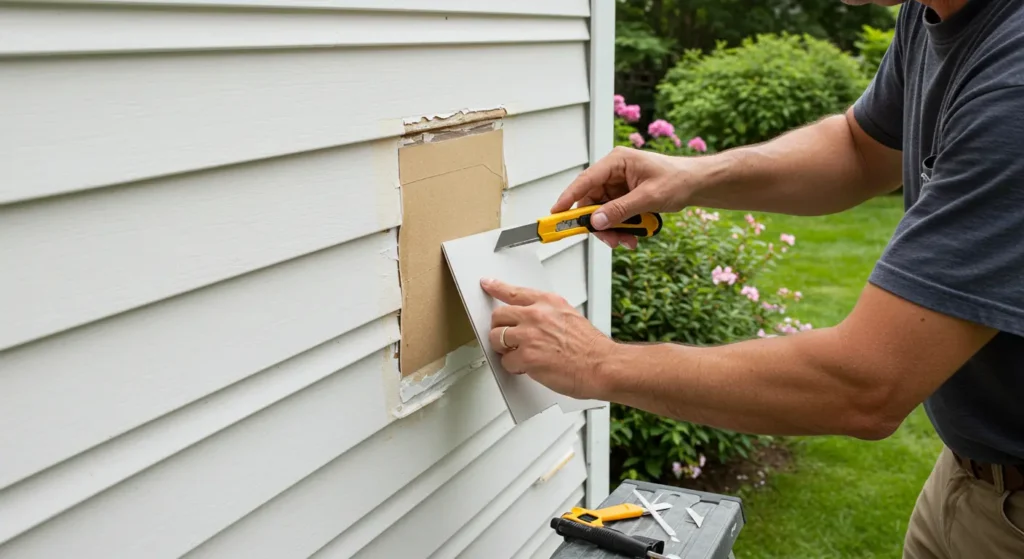
Some issues are best left to the pros, especially in storm-prone areas like Louisiana. Call a contractor when:
- There’s mold, mildew, or water damage behind the siding
- Multiple panels are warped, cracked, or missing
- The damage spans two stories or hard-to-reach areas
- You notice bubbling, blistering, or separation from the wall
Calling in local experts ensures proper installation and avoids future problems. Lone Wolf Siding offers free inspections and affordable siding repair services across Louisiana.
How Much Does Vinyl Siding Repair Cost?
The cost to repair vinyl siding depends on the extent of damage and whether you DIY or hire a professional.
DIY Costs:
- Patch kit: $10–$30
- Caulk & sealant: $5–$20
- Replacement panel: $15–$40 per panel
- Zip tool: $10–$15
Average total for small DIY fix: $30–$100
Professional Repair Costs:
- Minor repairs: $150–$400
- Moderate replacement: $500–$1,000
- Extensive repairs (multiple panels): $1,200+
Check our detailed siding cost guide to learn what impacts pricing and when insurance might cover repairs.
Maintenance Tips to Prevent Future Siding Damage
Preventive care can save you hundreds in repair costs. Follow these siding maintenance tips:
- Inspect annually: Check for cracks, loose panels, mold, or warping.
- Clean your siding at least once a year with a hose or soft brush.
- Seal around windows and doors with exterior caulk.
- Avoid placing grills or heat sources close to siding.
- Trim trees and bushes to prevent branch damage during storms.
- Check after hurricanes or hailstorms: Prompt action can prevent rot.
Louisiana homeowners should inspect siding after every major storm, especially during hurricane season.
Final Thoughts
Fixing vinyl siding can seem intimidating, but with the right tools, some patience, and this guide, many repairs are entirely manageable. For homeowners in Louisiana, where siding is constantly exposed to harsh storms and high humidity, regular maintenance and quick fixes can go a long way in protecting your home’s structure and energy efficiency.
If you’re unsure of the damage or need expert help, trust Lone Wolf Siding; your local, experienced siding team. Whether it’s a small patch or a full storm repair, we’re here to help.
FAQs About Vinyl Siding Repair
Can vinyl siding be repaired without replacing it?
Yes. Small cracks, holes, or chips can be patched with caulk or vinyl repair kits. Larger damage may require full panel replacement.
How long does a vinyl siding repair last?
Properly installed repairs can last 10–15 years, especially when maintained. Caulking and patch materials should be checked annually.
What’s the average cost to repair vinyl siding?
DIY repairs may cost as little as $30–$100. Professional repairs range from $150 to $1,200, depending on damage severity. View our siding cost breakdown.
What causes vinyl siding to warp or crack?
- Heat exposure
- Poor installation
- Storm debris or hail
- Aging material
- Improper nailing (too tight)
What tools do I need to fix vinyl siding?
Essentials include:
- Vinyl siding zip tool
- Utility knife
- Hammer/drill
- Replacement panels
- Exterior caulk
- Safety gear (gloves, ladder)
Book a Free Siding Inspection Today
Don’t let minor siding issues turn into major repairs. Contact us today to schedule a free siding inspection and keep your home protected year-round.

